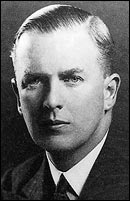Josslyn Hay, 22nd Earl of Erroll
| James Hay | |
|---|---|

Lord Erroll in 1941.
|
|
| Born |
11 May 1901 Mayfair, Westminster, UK |
| Died | 24 January 1941 (aged 39) Ngong, British Kenya |
| Cause of death | Murder |
| Title | 22nd Earl of Erroll |
| Tenure | 1928 – 1941 |
| Other titles | Baron Kilmarnock |
| Known for | Fascist sympathizer; murder victim |
| Nationality | British |
| Residence | Nairobi, Kenya |
| Predecessor | Victor Hay, 21st Earl of Erroll |
| Successor | Diana Hay, 23rd Countess of Erroll |
| Spouse(s) | Lady Idina Sackville (m. 1923; div. 1930) |
| Issue | Diana Hay, 23rd Countess of Erroll |
| Occupation | Landowner |
Josslyn Victor Hay, 22nd Earl of Erroll (11 May 1901 – 24 January 1941) was a British peer, famed for the unsolved case surrounding his murder and the sensation it caused during wartime in Britain.
Hay was the eldest son of the diplomat Victor Hay, Lord Kilmarnock (later Earl of Erroll) and his wife Lucy, the only daughter of Sir Allan Mackenzie, 2nd Baronet. In 1911, he attended the coronation of George V and carried his grandfather's coronet. He began at Eton College in 1914 but was dismissed two years later.
Although possessing one of Scotland's most distinguished titles, the earls, by this time, had no wealth, and had to develop careers to earn their living. In 1920, Hay was appointed honorary attaché at Berlin under his father, who was earlier appointed chargé d'affaires there before the arrival of Edgar Vincent, 1st Viscount D'Abernon. His father was soon appointed High Commissioner to the Rhineland, but Hay stayed in Berlin and served under Lord D'Abernon until 1922.
After passing the Foreign Office examinations, Hay was expected to follow his father into diplomacy, but instead became infatuated with Lady Idina Sackville, a daughter of Gilbert Sackville, 8th Earl De La Warr, divorced wife of the politician Euan Wallace and the wife of Charles Gordon. Lady Idina soon divorced her husband in 1923 and she and Hay were married on 22 September 1923.
After causing a society scandal due to their marriage – she was twice-divorced, notoriously unconventional in many ways, and eight years his senior – Hay and his wife moved to Kenya in 1924, financing the move with Idina's money. Their home was a bungalow on the slopes of the Aberdare Range which they called Slains, after the former Hay family seat of Slains Castle which was sold by Hay's grandfather, the 20th Earl, in 1916. The bungalow was sited alongside the high altitude farms which other white Kenyans were establishing at the time.
...
Wikipedia
